The AMD A10-7700K and AMD A6-7400K CPU Mini-Review
by Ian Cutress on May 27, 2015 9:00 AM ESTGaming Benchmarks
As mentioned previously, this mini-review will focus on a few elements but all our data can be found in Bench, including tests with high end ($300+) graphics cards and some 4K testing.
Alien: Isolation
If first person survival mixed with horror is your sort of thing, then Alien: Isolation, based off of the Alien franchise, should be an interesting title. Developed by The Creative Assembly and released in October 2014, Alien: Isolation has won numerous awards from Game Of The Year to several top 10s/25s and Best Horror titles, ratcheting up over a million sales by February 2015. Alien: Isolation uses a custom built engine which includes dynamic sound effects and should be fully multi-core enabled.
For low end graphics, we test at 720p with Ultra settings, whereas for mid and high range graphics we bump this up to 1080p, taking the average frame rate as our marker with a scripted version of the built-in benchmark.
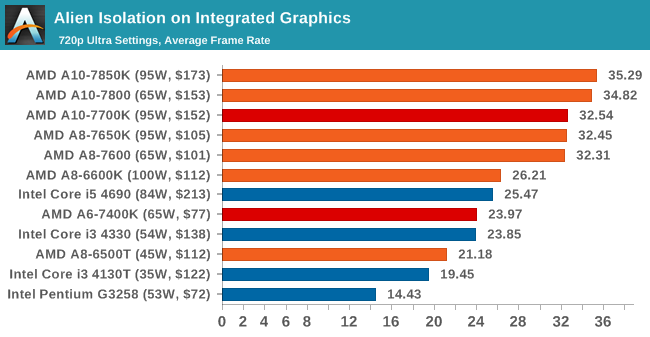
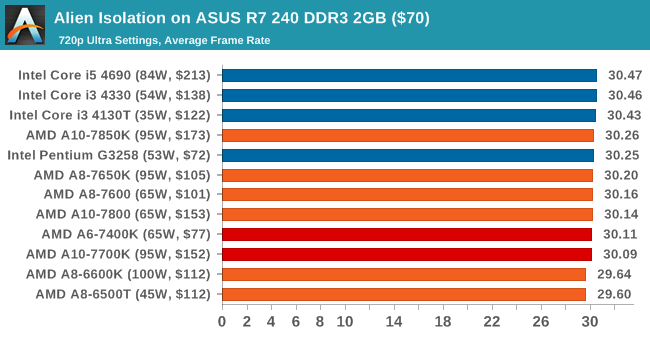
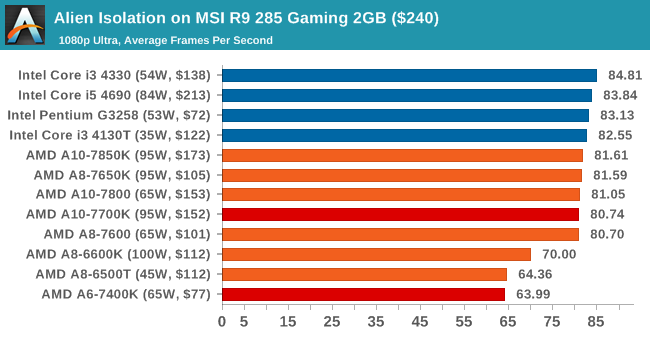
Total War: Attila
The Total War franchise moves on to Attila, another The Creative Assembly development, and is a stand-alone strategy title set in 395AD where the main story line lets the gamer take control of the leader of the Huns in order to conquer parts of the world. Graphically the game can render hundreds/thousands of units on screen at once, all with their individual actions and can put some of the big cards to task.
For low end graphics, we test at 720p with performance settings, recording the average frame rate. With mid and high range graphics, we test at 1080p with the quality setting. In both circumstances, unlimited video memory is enabled and the in-game scripted benchmark is used.
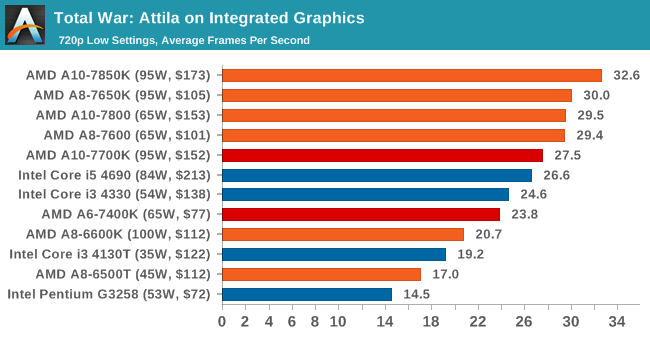
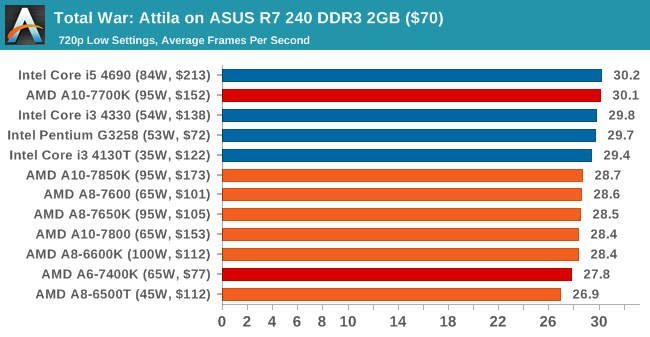
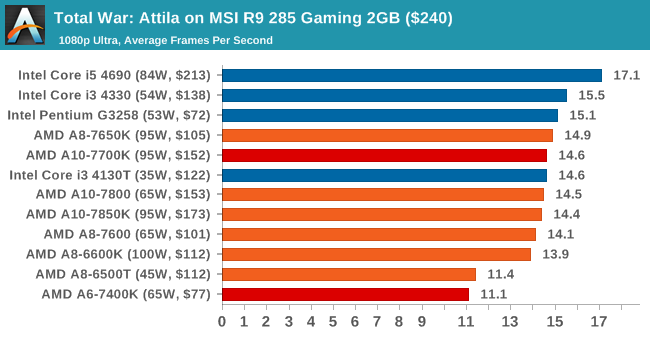
Grand Theft Auto V
The highly anticipated iteration of the Grand Theft Auto franchise finally hit the shelves on April 14th 2015, with both AMD and NVIDIA in tow to help optimize the title. GTA doesn’t provide graphical presets, but opens up the options to users and extends the boundaries by pushing even the hardest systems to the limit using Rockstar’s Advanced Game Engine. Whether the user is flying high in the mountains with long draw distances or dealing with assorted trash in the city, when cranked up to maximum it creates stunning visuals but hard work for both the CPU and the GPU.
For our test we have scripted a version of the in-game benchmark, relying only on the final part which combines a flight scene along with an in-city drive-by followed by a tanker explosion. For low end systems we test at 720p on the lowest settings, whereas mid and high end graphics play at 1080p with very high settings across the board. We record both the average frame rate and the percentage of frames under 60 FPS (16.6ms).

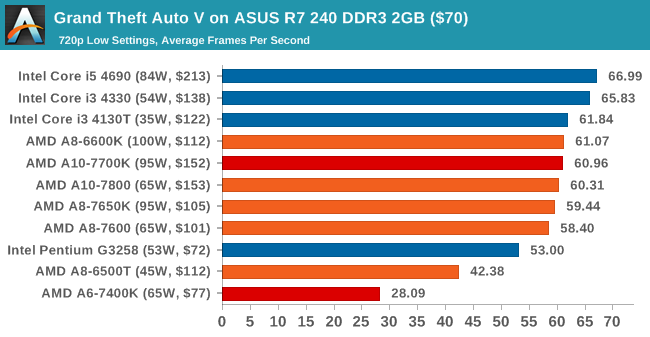
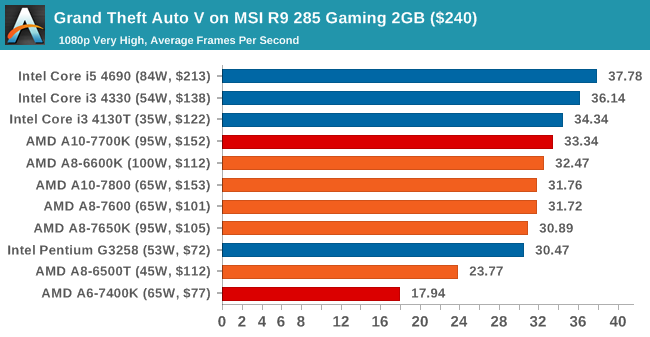
GRID: Autosport
No graphics tests are complete without some input from Codemasters and the EGO engine, which means for this round of testing we point towards GRID: Autosport, the next iteration in the GRID and racing genre. As with our previous racing testing, each update to the engine aims to add in effects, reflections, detail and realism, with Codemasters making ‘authenticity’ a main focal point for this version.
GRID’s benchmark mode is very flexible, and as a result we created a test race using a shortened version of the Red Bull Ring with twelve cars doing two laps. The car is focus starts last and is quite fast, but usually finishes second or third. For low end graphics we test at 1080p medium settings, whereas mid and high end graphics get the full 1080p maximum. Both the average and minimum frame rates are recorded.

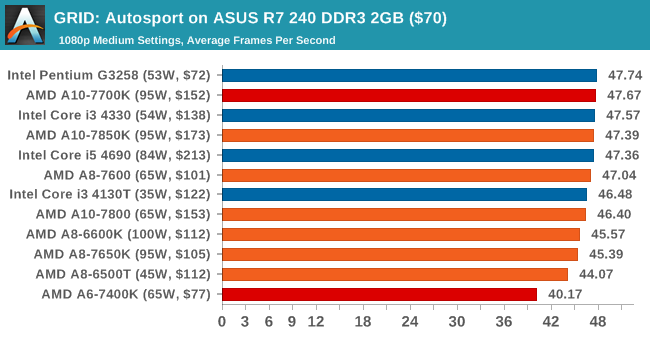
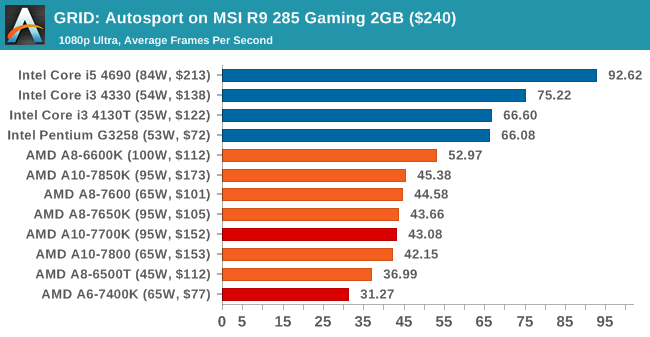
Middle-Earth: Shadows of Mordor
The final title in our testing is another battle of system performance with the open world action-adventure title, Shadows of Mordor. Produced by Monolith using the LithTech Jupiter EX engine and numerous detail add-ons, SoM goes for detail and complexity to a large extent, despite having to be cut down from the original plans. The main story itself was written by the same writer as Red Dead Redemption, and it received Zero Punctuation’s Game of The Year in 2014.
For testing purposes, SoM gives a dynamic screen resolution setting, allowing us to render at high resolutions that are then scaled down to the monitor. As a result, we get several tests using the in-game benchmark. For low end graphics we examine at 720p with low settings, whereas mid and high end graphics get 1080p Ultra. The top graphics test is also redone at 3840x2160, also with Ultra settings, and we also test two cards at 4K where possible.

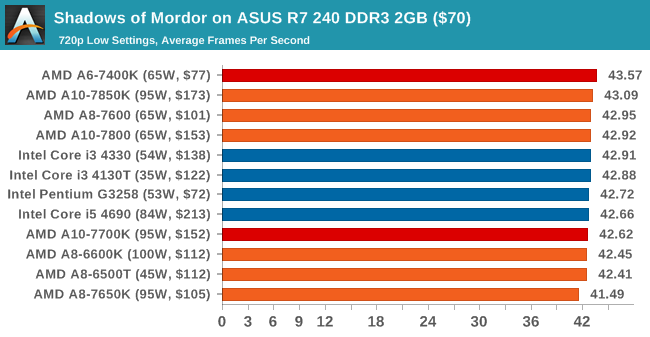
![Shadows of Mordor on MSI R9 285 Gaming 2GB ($240) [Minimum FPS]](https://images.anandtech.com/graphs/graph9287/74558.png)
I added some 4K numbers here, just to see the difference at a higher resolution. It turns out that for average frame rates at least, Shadows of Mordor is CPU agnostic. A fast CPU gets a higher rating in minimum frames however.







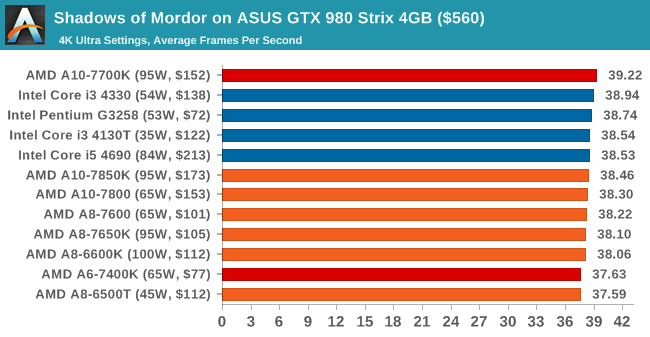
![Shadows of Mordor on ASUS GTX 980 Strix 4GB ($560) [Minimum FPS]](https://images.anandtech.com/graphs/graph9287/74592.png)








105 Comments
View All Comments
leexgx - Thursday, May 28, 2015 - link
they need to update CPU-z to correctly show that the Modular CPU on the new cpus of AMDor at least show core as modules as they are effectively a single core CPU or dual core performance wise, AMD currently does not have a Quad core CPU in the current line up (Quad Module)
akamateau - Thursday, May 28, 2015 - link
I can't disagree with your assessmant of AMD marketing. It is non-existant. But what is worse is when wirters such as Ian Cutress LIE to their readers.These new AMD releases ALL are meant for Windows 10 and DX12. Where are the DX12 benchmarks?
Cutress has 3dMark API Overhead and Starswarm yet he benches new products with an OBSOLETE API: DX11.
Why doesnlt he bench them using DX12?
As a wrieter Cutress is obkiged to write about ALL of the facts not just those that he wants the consumer to know or those facts that Intel pays him to cover-up.
So Cutress what;s it going to be? Are you GUTLESS or do you have the STONES to show us the DX12 benchmarks?
jospoortvliet - Thursday, May 28, 2015 - link
These APU's are only useful for playing old games - DirectX 11, thus. Those fancy, non-existent DirectX 12 games will most likely be too heavy for it anyway. Heck, he should test DirectX 9 games, rather than DX 11...UtilityMax - Friday, May 29, 2015 - link
And guess what, as you can see from the benchmarks, the iGPU from the A10 line does not make almost any difference over the iGPU from the A8 line. On paper, A10 has 1/3 mode GPU processing units, but in reality both are starved for memory bandwidth, so it makes almost no difference if you use A10 or A8 GPU. Looking at all the benchmarks, the A8-7600 is the most solid choice among the Kaveri parts. It loses almost nothing to the A10 line in terms of performance, while costing less and burning less power.ES_Revenge - Saturday, May 30, 2015 - link
Keep in mind there *are* i5s that are dual-core--essentially i3s with turbo. Clarkdale i5s (i5-6xx) are all that way, and ALL laptop/mobile i5s are dual-core + HT + turbo. I'm not saying the 7700K should have the A10 name (it shouldn't, I agree) but it's not like Intel doesn't have exceptions to their branding as well.Shadowmaster625 - Wednesday, May 27, 2015 - link
That A8-7650K is a really nice part. The 7700k seems rather redundant.xenol - Wednesday, May 27, 2015 - link
I can't wait for a Zen based APU with HBM. I'm yawning at seeing Bulldozer derivatives.r3loaded - Wednesday, May 27, 2015 - link
Yep, especially when a $72 Intel CPU matches or beats all of AMD's offerings in everything except iGPU gaming and heavily multithreaded workloads.Edens_Remorse - Wednesday, May 27, 2015 - link
You are mistaken if you think the G3258 beats the 860k in gaming when discrete graphics are involved.nandnandnand - Wednesday, May 27, 2015 - link
Anything pre-Zen from AMD is a waste of space at this point.